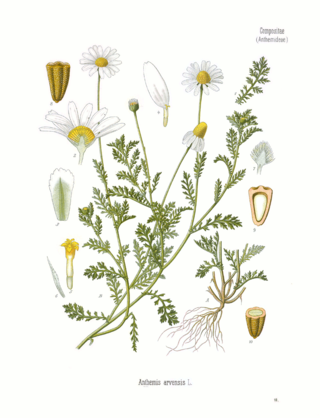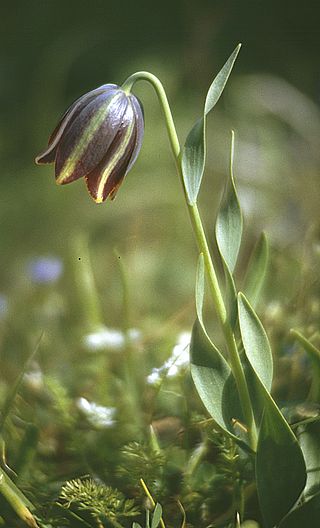
The genus Ophrys is a large group of orchids from the alliance Orchis in the subtribe Orchidinae. They are widespread across much of Europe, North Africa, Caucasus, the Canary Islands, and the Middle East as far east as Turkmenistan.
Iris illyrica, the Illyrian iris, is a perennial plant from the iris family (Iridaceae), native to Southeastern Europe.

Anthemis arvensis, also known as corn chamomile, mayweed, scentless chamomile, or field chamomile is a species of flowering plant in the genus Anthemis, in the aster family. It is used as an ornamental plant.

Ophrys sphegodes, commonly known as the early spider-orchid, is a species of sexually-deceptive orchid native to Europe and the Middle East. It is a very varied species with many subspecies recognised.

Fritillaria pyrenaica is a species of flowering plant in the lily family Liliaceae, native to the Pyrenees in Spain and France. Common names include Pyrenean fritillary and Pyrenean snake's-head. It is a bulbous perennial growing to 45 cm (18 in). The pendent, bell-shaped flowers are borne in spring. They have recurved tepals which are purple tinged with brown and yellow. Like other species in this genus, notably F. meleagris, they are strongly chequered.

Senecio leucanthemifolius is a plant common in sea-side in Mediterranean area.

Fritillaria graeca is a European plant species in the family Liliaceae. It is native to the Balkans. Some older literature says that the plant can also be found in Serbia, but all these collections are of var. gussichiae, now regarded as a distinct species called Fritillaria gussichiae.

Spilostethus pandurus is a species of "seed bugs" belonging to the family Lygaeidae, subfamily Lygaeinae.

Aporophyla canescens is a species of moth in the family Noctuidae. It was described by Philogène Auguste Joseph Duponchel in 1826. It is found in Italy, Switzerland, Slovenia, Croatia, Albania, Bosnia and Herzegovina, Serbia, North Macedonia, Greece, Turkey, Israel, Portugal, Russia, as well as on Sardinia, Corsica, Sicily, Malta and Crete.

Pleurota pyropella is a moth of the family Oecophoridae. It is found in Portugal, France, Germany, Italy, Austria, Switzerland, the Czech Republic, Slovakia, Albania, Croatia, Slovenia, Bosnia and Herzegovina, Serbia, Hungary, Bulgaria, Romania, North Macedonia, Greece, Turkey, Ukraine, Russia, as well as on Corsica, Sicily, Cyprus and Crete. Outside of the Europe, the range extends to the eastern Palearctic. The species is also present in the Near East and North Africa.

Fritillaria tubiformis is a bulbous perennial plant in the lily family Liliaceae, native to Alpine regions of southwestern France and northern Italy.

Fritillaria montana is a European species of flowering plant in the lily family Liliaceae, native to southern and eastern Europe: France, Italy, Greece, Austria, Hungary, Yugoslavia, Albania, Bulgaria, Romania, Ukraine, European Russia.

Fritillaria gussichiae is a European plant species in the lily family Liliaceae, native to Bulgaria, North Macedonia, Serbia, Albania, and Greece.

Fritillaria macedonica is a European species of flowering plant in the lily family Liliaceae, native to Albania, North Macedonia, Greece and Serbia.

Fritillaria rhodocanakis is a species of plant in the lily family Liliaceae. In its pure form, it is found only on Hydra Island and on small neighboring islands in Greece. Additional populations occur in the Peloponnisos region of mainland Greece, though the specimens there show some degree of hybridization with F. spetsiotica and F. graeca. In 1987, some of the hybrids were described with the name Fritillaria rhodocanakis subsp. argolica, but this is now generally referred to as Fritillaria × spetsiotica Kamari.

Fritillaria lusitanica is a species of plant in the lily family Liliaceae, endemic to the Iberian Peninsula.

Crepis neglecta is a species of flowering plant in the sunflower family, Asteraceae. It ranges from east-central to southeastern Europe and northwestern Turkey.

Cynanchica aristata, commonly known as woodruff, is a deciduous species of perennial groundcover, and a flowering plant in the family Rubiaceae. It is native to Morocco, Libya, Algeria, Tunisia, Azerbaijan, Georgia, Armenia, Greece, Bulgaria, Albania, Serbia, North Macedonia, Croatia, Italy, Austria, Switzerland, France, Spain, and Portugal.

Anthemis cretica, the Cretian mat daisy or white mat chamomile, is a species of flowering plant in the family Asteraceae. It or its many subspecies can be found around the Mediterranean region, the Black Sea area, Poland, the Caucasus, and the Middle East as far as Iran. It is highly morphologically variable, and the namesake of a species complex.


















